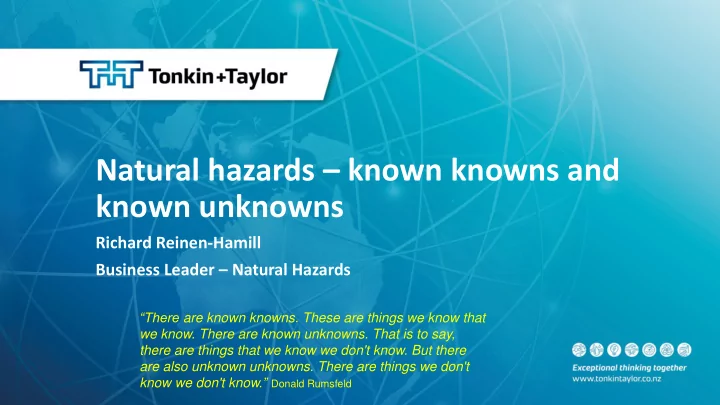

Natural hazards – known knowns and known unknowns Richard Reinen-Hamill Business Leader – Natural Hazards “There are known knowns. These are things we know that we know. There are known unknowns. That is to say, there are things that we know we don't know. But there are also unknown unknowns. There are things we don't know we don't know .” Donald Rumsfeld
Overview • Natural hazards and how do they affect NZ • Four examples of Natural Hazards and their impacts: Canterbury Earthquake Sequence – climate change Tsunami Inundation risk in Tauranga Coastal erosion – addressing uncertainty and precautionary Landslide and fluidization
Natural Hazards Natural Hazard A potential damaging physical event that may cause loss of life, injury or other health impacts, property damage, social and economic disruption, or environmental damage. Risk The probability of harmful consequences, or expected losses resulting from interactions between hazards and vulnerable conditions R = Likelihood of a hazard x consequence is the most common NZ definition. Disaster = Emergency in CDEM Act
Top 10 Natural Disasters in NZ from 1900 to 2014 by fatalities
Top 10 Natural Disasters in NZ from 1900 to 2014 by total affected
Top 10 Natural Disasters in NZ from 1900 to 2014 by economic damage costs
The numbers
SETTLEMENT DAMAGE LIQUEFIED SAND EJECTS THROUGH CRUST GROUNDWATER LEVEL SHAKING LIQUEFIES SATURATED FINE SAND/ SILTY SAND
Sea Level Rise
0m SLR 0.5m SLR 1.0m SLR MINOR MINOR MINOR 22% 27% 38% LSN < 1 6 NONE/MINOR LAND DAMAGE LSN 16 to 25 MINOR/MODERATE LAND DAMAGE LSN > 25 SEVERE LAND DAMAGE MINOR LAND DAMAGE: SEVERE MODERATE
SEA LEVEL RISE LAND DAMAGE BUILDING DAMAGE MINOR $ Repair Cost 22% 26% 0m $ Replacement > 50% MINOR 27% 33% 20% to 50% 0.5m < 50% MINOR 38% 44% 1.0m
Key findings • Liquefaction hazard risk varies with ground water level • Sea level rise is likely to increase the severity of liquefaction effects in low lying coastal plains and reclaimed land
Tauranga tsunami evacuation planning
Tsunami modelling • Modelled maximum probable tsunami from Kermedec Fault • Travel time approx. 50 minutes to reach coast • Wave heights up to 14m over Papamoa frontal dunes but height varied along the coast • Inundation up to 2 km inland • Up to 90 minutes to flood to maximum inland extents
Key findings • Nearfield tsunamis make it difficult for managed evacuation • Shore parallel roads do not help • Combination of improved education and urban design features will help self evacuation • Depth and velocity information useful for both damage and harm assessments
Coastal erosion • Historically components summed assuming complete dependence – increases conservatism • Uncertainty is included within a factor of safety – increases conservatism • Have previously been used to derive maximum potential extents • Not consistent with risk-based approach • Difficult to define different levels of likelihood as required under NZCPS
Probabilistic CEHZ Assessment Approach CEHZ Beach [ ST DS LT T SL ]
Probabilistic CEHZ Assessment Approach • Example – Waipu Cove 2115 • Probabilistic hazard zone defined
Probabilistic CEHZ Assessment Approach Example – Waipu Cove 2115 Probabilistic hazard zone defined How do we relate to terminology of NZCPS? Likely - Probability exceeded by 66% of events – exceeded by 5% of events Potential MfE (2008)
Probabilistic CEHZ Assessment Approach Example – Waipu Cove 2115 Probabilistic hazard zone defined How do we relate to terminology of NZCPS? Likely - Probability exceeded by 66% of events Potential – exceeded by 5% of events P 5% P 66 % ‘ Potential ’ ‘ Likely ’
Matata Debris Flow – 17 to 18 May 2008
Catchment response 100 year 100 ear 18 18 May (m 3 /s) (m 3 /s) (m Deb Debris Deb Debris Fl Flood Fl Flow Pik Pikowai 68 135 Oh Ohinekoao 61 85 210 Awatarariki 44 66 325 Waim imea 7 Waim imea 4 11 20 to 30 sou southern trib ibutary Wait itepuru 14 180 to 270
Key findings • Rainfall maybe 20 % greater than expected 100 year rainfall • Water flows in streams up to twice expected 100 year flows • Water and debris flows up to maybe twenty times 100 year flood flows
Questions?
Recommend
More recommend